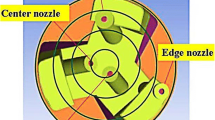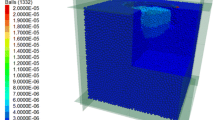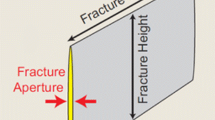Abstract
A numerical technique based on a CFD-DEM method is presented for the analysis of particle impact drilling (PID) systems. The method is built from a preexisting finite element Navier–Stokes solver for the fluid phase and a discrete element method module for the steel particles which this drilling technology utilizes to enhance the penetration rate. We provide a detailed description of the most relevant implementation issues, including our choice of the hydrodynamic forces appropriate for power-law fluids. We also discuss several critical aspects related to the validity of the simplifying assumptions that will be helpful to simulation engineers. We apply our simple, one-way coupled approach on designs provided by an industrial partner to illustrate its potential as an analysis tool for this promising drilling technology. The goal of this work is, on the one hand, to provide evidence for the usefulness of the numerical approach as a design tool for PID systems, as well as a detailed discussion of the different aspects to be assessed for an effective simulation campaign. On the other hand, a series of modeling aspects that require further work are identified. The focus of the simulation campaign presented is on the particles and fluid flow characteristics within the drill bit.


















Similar content being viewed by others
References
Ron L (2006) Bit technology keeps pace with operator activity. World Oil 227(11):71–80
Zhao J, Yiji X (2014) The technical development for increasing ROP with particle impact drilling in China. Adv Mater Res 904:292–295
Rach NM (2007) Particle-impact drilling blasts away hard rock. Oil Gas J 105(6):43–48
Tibbitts GA, Galloway GG (2008) Particle drilling alters standard rock-cutting approach: drilling/completions. World Oil 229(6):37–44
l Yan T, Li J, Zhao L (2016) Numerical simulation on flow field of particle impact drilling in different drilling parameters. DEStech Trans Comput Sci Eng, (Icte):1–5. https://doi.org/10.12783/dtcse/icte2016/4801
Zhao J, Yiji X, Ren J, Hou D (2014) Numerical simulation of the bottom hole flow field of particle impact drilling. Adv Petrol Explor Dev 8(2):18–23
Ren FS, Ma RX, Cheng XZ (2014) Simulation of particle impact drilling nozzles based on fluent. Adv Mater Res 988:475–478
Lingbi JGWHW, Rongchao CMC (2012) Numerical simulation research on the bit nozzle flow field of particle impact drilling. China Petrol Mach, (10):6. https://en.cnki.com.cn/Article_en/CJFDTotal-SYJI201210006.htm
Zhou W, Huang J, Li L (2018) Numerical simulation of bottomhole flow field structure in particle impact drilling. E&ES 108(3):032080
Meng C, Ying-hu Z, Guo-dong J (2011) Experimental study of rock breaking effect of steel particles. J Hydrodyn Ser B 23(2):241–246
Kuerten JGM (2016) Point-particle DNS and les of particle-laden turbulent flow-a state-of-the-art review. Flow, Turbul Combus 97(3):689–713
Subramaniam S (2013) Lagrangian-Eulerian methods for multiphase flows. Prog Energy Combus Sci 39(2–3):215–245
Cleary PW (2004) Large scale industrial DEM modelling. Eng Comput 21(2-4):169–204. https://doi.org/10.1108/02644400410519730
Guo Yu, Curtis JS (2015) Discrete element method simulations for complex granular flows. Ann Rev Fluid Mech 47(1):21–46
Samiei K, Peters B, Bolten M, Frommer A (2013) Assessment of the potentials of implicit integration method in discrete element modelling of granular matter. Comput Chem Eng 49:183–193
Lichtenheldt R (2017) A stable, implicit time integration scheme for discrete element method and contact problems in dynamics. In: PARTICLES V: proceedings of the V international conference on particle-based methods: fundamentals and applications, pp. 297–308. CIMNE
Richardson DC, Walsh KJ, Murdoch N, Michel P (2011) Numerical simulations of granular dynamics: I. hard-sphere discrete element method and tests. Icarus 212(1):427–437
Williams JR, O’Connor R (1995) A linear complexity intersection algorithm for discrete element simulation of arbitrary geometries. Eng Comput 12(2):185–201
Santasusana M, Irazábal J, Oñate E, Carbonell JM (2016) The double hierarchy method. A parallel 3D contact method for the interaction of spherical particles with rigid FE boundaries using the DEM. Comput Part Mech 3(3):407–428
Wensrich CM, Katterfeld A (2012) Rolling friction as a technique for modelling particle shape in dem. Powder Technol 217:409–417
Loth E(2010) Particles drops and bubbles: Fluid dynamics and numerical methods
Ayala O, Grabowski WW, Wang LP (2007) A hybrid approach for simulating turbulent collisions of hydrodynamically-interacting particles. J Comput Phys 225(1):51–73
Rosa B, Wang L-P, Maxey MR, Grabowski WW (2011) An accurate and efficient method for treating aerodynamic interactions of cloud droplets. J Comput Phys 230(22):8109–8133
Casas G, Mukherjee D, Celigueta MA, Zohdi TI, Onate E (2017) A modular, partitioned, discrete element framework for industrial grain distribution systems with rotating machinery. Comput Part Mech 4(2):181–198
Thornton C, Cummins SJ, Cleary PW (2013) An investigation of the comparative behaviour of alternative contact force models during inelastic collisions. Powder Technol 233:30–46
Ramírez R, Pöschel T, Brilliantov NV, Schwager T (1999) Coefficient of restitution of colliding viscoelastic spheres. Phys Rev E 60(4):4465–4472
Lifshitz JM, Kolsky H (1964) Some experiments on anelastic rebound. J Mech Phys Solids 12(1):35–43
Aguilar-Corona A, Zenit R, Masbernat O (2011) Collisions in a liquid fluidized bed. Int J Multiph Flow 37(7):695–705
Padding JT, Louis AA (2006) Hydrodynamic interactions and Brownian forces in colloidal suspensions: coarse-graining over time and length scales. Phys Rev E - Stat, Nonlinear, Soft Matter Phys 74(3):1–31
Wasfy TM, Noor AK (2003) Computational strategies for flexible multibody systems. Appl Mech Rev 56(6):553–613
O’Sullivan C, Bray JD (2004) Selecting a suitable time step for discrete element simulations that use the central difference time integration scheme. Eng Comput
Harald Kruggel-Emden M, Sturm SW, Scherer V (2008) Selection of an appropriate time integration scheme for the discrete element method (dem). Comput Chem Eng 32(10):2263–2279
Antypov D, Elliott JA (2011) On an analytical solution for the damped Hertzian spring. EPL (Europhys Lett) 94(5):50004
Coussot P, Bertrand F, Herzhaft B (2004) Rheological behavior of drilling muds, characterization using MRI visualization. Oil Gas Sci Technol 59(1):23–29
Löhner R (2008) Applied computational fluid dynamics techniques. John Wiley & Sons Ltd, Chichester
Druzhinin OA, Elghobashi S (1998) Direct numerical simulations of bubble-laden turbulent flows using the two-fluid formulation. Phys Fluids 10(3):685–697
Casas González Guillermo (2018) Numerical analysis of particle-laden flows with the finite element method. PhD thesis, Universitat Politècnica de Catalunya
Loth E, Dorgan AJ (2009) An equation of motion for particles of finite Reynolds number and size. Environ Fluid Mech 9(2):187–206
Coimbra CFM, Rangel RH (2001) Spherical particle motion in harmonic stokes flows. AIAA J 39(9):1673–1682
Winkler CM, Rani SL (2009) Relative importance of the lift force on heavy particles due to turbulence driven secondary flows. Powder Technol 190(3):310–318
Marchioli C, Picciotto M, Soldati A (2007) Influence of gravity and lift on particle velocity statistics and transfer rates in turbulent vertical channel flow. Int J Multiph Flow 33(3):227–251
Lataste J, Huilier D, Burnage H, Bednář J (2000) On the shear lift force acting on heavy particles in a turbulent boundary layer. Atmos Environ 34(23):3963–3971
Auton TR, Hunt JCR, Prud’Homme M (1988) The force exerted on a body in inviscid unsteady non-uniform rotational flow. J Fluid Mech 197(1):241
Loth E (2008) Lift of a spherical particle subject to vorticity and/or spin. AIAA J 46(4):801–809
Wakaba L, Balachandar S (2007) On the added mass force at finite Reynolds and acceleration numbers. Theor Comput Fluid Dyn 21(2):147–153
Kendoush AA, Sulaymon AH, Mohammed SAM (2007) Experimental evaluation of the virtual mass of two solid spheres accelerating in fluids. Exp Thermal Fluid Sci 31(7):813–823
Maxey MR (1983) Equation of motion for a small rigid sphere in a nonuniform flow. Phys Fluids 26(4):883–889
Loth E (2008) Drag of non-spherical solid particles of regular and irregular shape. Powder Technol 182(3):342–353
Beetstra R, van der Hoef MA, Kuipers JAM (2007) Drag force of intermediate Reynolds number flow past mono- and bidisperse arrays of spheres. AIChE J 53(2):489–501
Azaiez J (2008) Bubbles, drops and particles in non-Newtonian fluids. R. P. Chhabra. Can J Chem Eng 85(2):251–252
Shah SN, El Fadili Y, Chhabra RP (2007) New model for single spherical particle settling velocity in power law (visco-inelastic) fluids. Int J Multiph Flow 33(1):51–66
Metzner AB, Reed JC (1955) Flow of non-Newtonian fluids–correlation of the laminar, transition, and turbulent-flow regions. AIChE J 1(4):434–440
Trinh KT (2010) On the critical Reynolds number for transition from laminar to turbulent flow. p. 39
Balachandar S (2009) A scaling analysis for point–particle approaches to turbulent multiphase flows. Int J Multiph Flow 35(9):801–810
Crowe C, Schwarzkopf J, Sommerfeld M, Tsuji Y (2012) Multiphase flows with droplets and particles. CRC Press, Boca Raton
Dadvand P, Rossi R, Oñate E (2010) An object-oriented environment for developing finite element codes for multi-disciplinary applications. Arch Comput Methods Eng 17(3):253–297
Coll J, Ribó AR, Pasenau M, Escolano E, Perez JSuit, Melendo A, Monros A, Gárate (2016) GiD v.13 Reference Manual. CIMNE
Thornton C (2009) A note on the effect of initial particle spin on the rebound behaviour of oblique particle impacts. Powder Technol 192(2):152–156
Sagaut P (2006) Large eddy simulation for incompressible flows: an introduction. Springer Science & Business Media, Berlin
Gupta P, Sun J, Ooi JY (2016) Dem-CFD simulation of a dense fluidized bed: wall boundary and particle size effects. Powder Technol 293:37–47
Boffi D, Brezzi F, Fortin M et al (2013) Mixed finite element methods and applications, vol 44. Springer, Berlin
Ern A, Guermond J-L (2004) Theory and practice of finite elements, applied mathematical sciences, vol 159. Springer, New York
Hughes Thomas JR (1995) Multiscale phenomena: green’s functions, the Dirichlet-to-Neumann formulation, subgrid scale models, bubbles and the origins of stabilized methods. Comput Methods Appl Mech Eng 127(1–4):387–401
Codina R (2001) A stabilized finite element method for generalized stationary incompressible flows. Comput Methods Appl Mech Eng 190(20–21):2681–2706
Codina R, Badia S, Baiges J, Principe J (2018) Variational multiscale methods in computational fluid dynamics. In: Stein E, de Borst R, Hughes TJR (eds) Encyclopedia of computational mechanics, 2nd edn. John Wiley, Hoboken, pp 1–28
Dalmau JC (2016) Applications of turbulence modelling in civil engineerng. PhD thesis, Universitat Politècnica de Catalunya
Wood WL, Bossak M, Zienkiewicz OC (1980) An alpha modification of Newmark’s method. Int J Numer Methods Eng 15(10):1562–1566
Funding
We acknowledge the financial support to CIMNE via the CERCA Programme/Generalitat de Catalunya, and also that provided by the Spanish Ministry of Economy and Competitiveness, through the “Severo Ochoa Programme for Centres of Excellence in R&D” (CEX2018-000797-S).
Author information
Authors and Affiliations
Corresponding author
Ethics declarations
Conflict of interest
The authors certify that they have NO affiliations with or involvement in any organization or entity with any financial interest (such as honoraria; educational grants; participation in speakers’ bureaus; membership, employment, consultancies, stock ownership, or other equity interest; and expert testimony or patent-licensing arrangements), or non-financial interest (such as personal or professional relationships, affiliations, knowledge, or beliefs) in the subject matter or materials discussed in this manuscript.
Additional information
Publisher's Note
Springer Nature remains neutral with regard to jurisdictional claims in published maps and institutional affiliations.
Appendices
Appendix
A Details of the numerical method for the fluid equations
1.1 A.1 Finite element discretization
The FEM is based on the weak version of the problem formed by Eqs. (5) and (6), which is to find \((\varvec{u}; p) \in \varvec{\mathcal {X}} :=\varvec{\mathcal {V}}_D \times \mathcal {Q}\), where \(\mathcal {V}_D\) and \(\mathcal {Q}\) are appropriate function spaces for the velocity (vectors already fulfilling the Dirichlet boundary conditions) and the pressure fields.
for all \((\varvec{v}; q)\) in \(\varvec{\mathcal {Y}} :=\varvec{\mathcal {V}_0} \times \mathcal {Q}\), where \(\varvec{\mathcal {V}_0}\) is the space of velocity-like fields that vanish on the Dirichlet boundary.
The basic strategy in the FEM is to replace the relevant (infinite-dimensional) spaces of functions above with finite dimensional counterparts in the variational version of the problem which leads to the algebraic system of equations that must be solved computationally.
Let us consider a conforming finite element partition \(\mathcal {T}_h\) of the domain \(\Omega \). For each element in the domain \(\Omega _e \in \mathcal {T}_h\), we denote its diameter as \(h_e\) and we define \(h = \max {\left\{ h_e | \Omega _e \in \mathcal {T}_h \right\} }\). With these tools, it is possible to construct the finite element spaces in the usual way, as \(\varvec{\mathcal {X}}_h = \varvec{\mathcal {V}}_{D,h} \times \mathcal {Q}_h\), with \(\mathcal {V}_{D,h} \subset \mathcal {V}_{D}\), \(\mathcal {Q}_h \subset \mathcal {Q}\). The finite element solution will be a function \(\varvec{U}_h = [\varvec{u}_h, p_h] \in \varvec{\mathcal {X}}_h\), and since we will be using equal-order spaces for the velocity and the pressure, the solution can be expressed as (summation is assumed for repeated indices)
for \(j = 1, ..., n_{\text {dim}}\) and \(b = 1, ..., n_{\text {nodes}}\); where the \(N^b\) are the shape functions, \(n_{\text {dim}}\) is the number of space dimensions (2 or 3), and \(n_{\text {nodes}}\) is the total number of mesh nodes.
Once the finite element discretization is defined, the problem presented in Eq. (30) can be expressed using a compact notation as find \(\varvec{U}_h\in \varvec{\mathcal {X}}_h\) such that
with
and
where we have divided through by the (constant) density of the fluid, \(\rho _f\).
1.1.1 Stabilization
In the present work, we want to make use of the simplest linear simplex elements, for both the pressure and velocity approximations. However, for problems of the form of Eq. (32) (i.e., saddle-point problem, see [61]) not all velocity–pressure element pairs lead to viable numerical methods. A necessary condition to guarantee the stability of a particular combination is that the finite element spaces must fulfil the inf-sup or Ladyzhenskaya–Babusška–Brezzi (LBB) condition [61], and, in particular, the equal-order, piecewise linear spaces for the velocity and for the pressure (\(\mathcal {P}_1/\mathcal {P}_1\) element) do not fulfil this condition [62]. Nonetheless, one can resort to stabilization methods to fix the numerical method resulting from the use of element pairs not fulfilling the LBB condition by modifying the weak form of the problem.
The variational multiscale method (VMS) [63, 64] method provides a theoretical framework for the development of stabilized finite element formulations. These are based on the explicit consideration of the decomposition of the continuous solution into a part belonging to the finite element space \(\varvec{\mathcal {X}}_h\) and its complement in the continuous solution space \(\tilde{\varvec{\mathcal {X}}}\), or subscale.
In this work, we consider the algebraic sub-grid scales (ASGS) variant of VMS [65], which leads to rewriting the problem Eq. (32) as find \(\varvec{U}_h\in \varvec{\mathcal {X}}_h\) such that
where \(B_{ASGS}(\varvec{U}_h,\varvec{V}_h)\) and \(L_{ASGS}(\varvec{V}_h)\) are computed by adding a number of stabilization terms to the analogous terms in Eqs. (33) and (34), respectively. The resulting discrete problem does not suffer from the numerical instabilities that affect the Galerkin problem and allows us to work with the simplest finite element pair. A detailed derivation of the stabilized equations can be found in [37, 66].
1.2 Time integration and linearized system of equations
After assembling all the elemental contributions and imposing the boundary conditions, Eq. (36) leads to a system of equations of the form
where \({\mathbb {U}}\) and \({\mathbb {P}}\) stand for the nodal unknowns of the velocity and pressure, respectively. For the time discretization, we use a second-order Bossak time integration scheme [67], which defines the velocities as

The Bossak method introduces a relaxation factor in the acceleration of the system in Eq. (37)
where n is the time-step index. Combining Eqs. (38) and (39) and rearranging terms, one can rewrite Eq. (39) in residual form as
where we choose \(\alpha = -0.3\) and \(\gamma _N = 1/2 - \alpha _B\), as this combination of parameters provides maximal damping of the highest frequencies and a robust behavior overall [67]. The nonlinearities present in Eq. (5) are linearized using a first-order Taylor expansion. That is, at each nonlinear iteration i one solves
Then, the solution and the residual are iteratively updated with Picard’s method as
where, in evaluating the derivative of the residual, we use the following approximation
where the indices are applied only to matrix \({\mathbb {C}}\), as \({\mathbb {M}}\) does not depend on the solution. Note that this approximation assumes that the variation of \({\mathbb {C}}\) is moderate compared to that of the solution vector itself; otherwise, convergence problems can appear. Consequently, the final system to be solved reads
Rights and permissions
About this article
Cite this article
Casas, G., de-Pouplana, I., Gandikota, R. et al. Numerical simulation of particle impact drilling (PID) systems: a one-way coupled approach. Comp. Part. Mech. 9, 735–757 (2022). https://doi.org/10.1007/s40571-021-00440-y
Received:
Revised:
Accepted:
Published:
Issue Date:
DOI: https://doi.org/10.1007/s40571-021-00440-y




